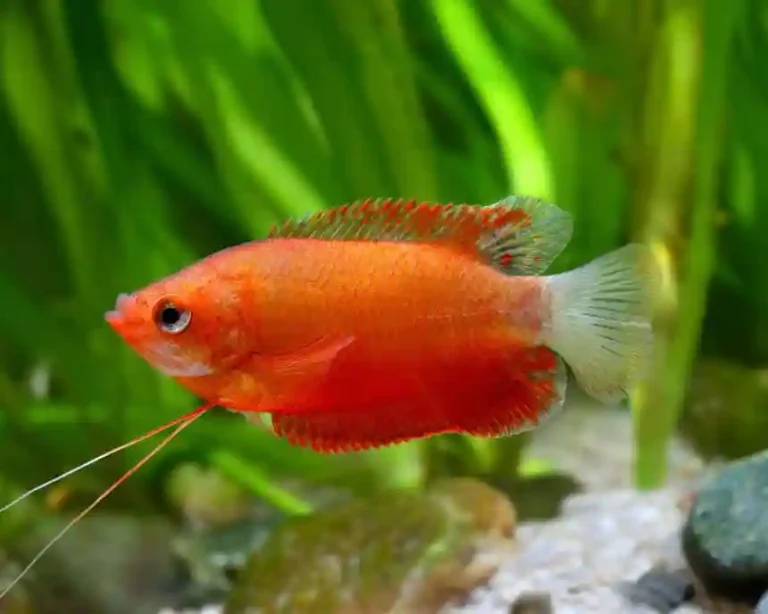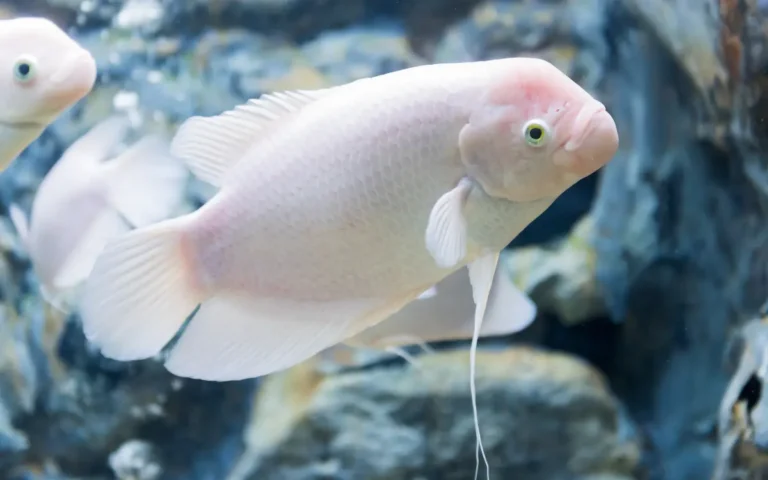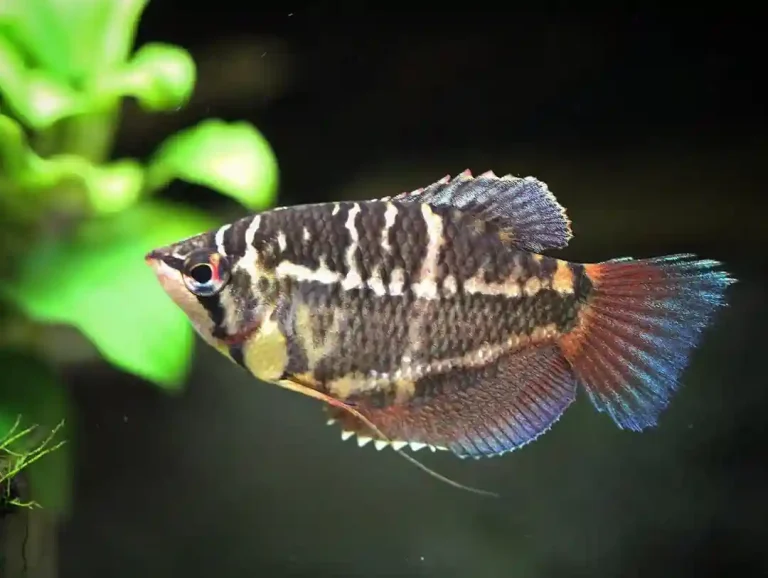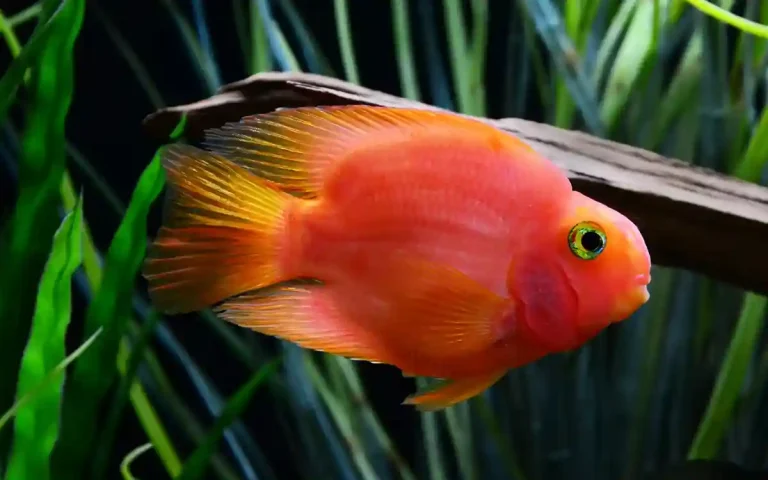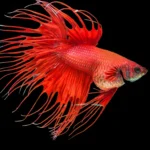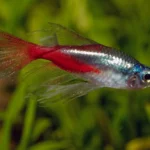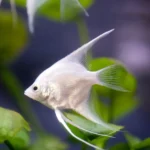If you’ve ever wanted a peaceful yet striking centerpiece for your aquarium, the Snakeskin Gourami (Trichopodus pectoralis) is worth considering. Known for their subtle silver body patterned with snake-like markings, these fish are calm, hardy, and surprisingly large compared to other gouramis.

Species Overview
The Snakeskin Gourami comes from Southeast Asia, where it inhabits rivers, ponds, rice paddies, and slow-moving streams. In the wild, they are sometimes harvested as food, but in the aquarium hobby they’re appreciated for their calm personality and adaptability.
- Scientific name: Trichopodus pectoralis
- Common names: Snakeskin Gourami
- Size: Up to 8–10 inches (20–25 cm)
- Lifespan: 7–10 years with good care
- Temperament: Peaceful, social, group-friendly
- Origin: Thailand, Vietnam, Cambodia, Malaysia
Unlike the more colorful Pearl or Dwarf Gourami, the Snakeskin has a muted appearance, but its grace and calmness make it stand out in community tanks.
Tank Setup for Snakeskin Gouramis
Tank Size Requirements
Snakeskin Gouramis can grow quite large for a gourami, so a minimum 40–55 gallon aquarium is recommended. A larger tank is even better if you plan to keep a small group. Their size and activity level mean they need space to swim comfortably.
Water Parameters
Snakeskin Gouramis are hardy and adaptable, but they thrive in stable, tropical freshwater conditions:
- Temperature: 75–82°F (24–28°C)
- pH: 6.0–7.5
- Hardness: Soft to moderately hard
They can tolerate slight variations, but sudden swings in water quality should be avoided.
Filtration and Aeration
Like all gouramis, they have a labyrinth organ, which lets them breathe air from the surface. This means they don’t require strong aeration, but you still need good filtration for water clarity. Use a gentle filter that won’t create excessive current, since they prefer calm waters.
Substrate and Decorations
- Substrate: fine sand or smooth gravel
- Plants: floating plants (duckweed, water lettuce) and rooted plants (Amazon swords, crypts) provide cover and reduce stress
- Driftwood or caves: optional but helpful for hiding places
Lighting
These fish feel most comfortable in subdued lighting. Floating plants can help diffuse light and mimic their natural habitat.
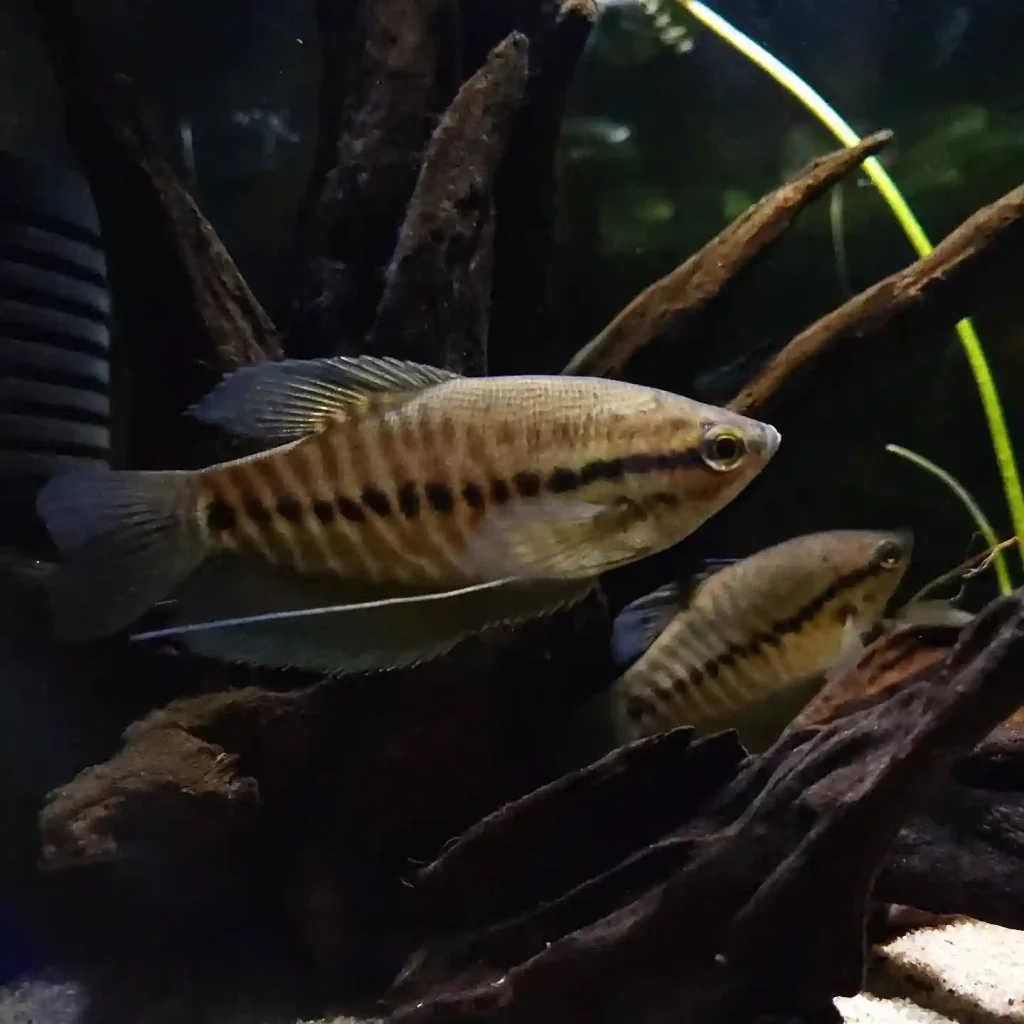
Tank Mates for Snakeskin Gourami
Snakeskin Gouramis are known for being peaceful community fish. They rarely nip fins or bully tank mates, making them versatile companions.
Good Tank Mates:
- Barbs (non-aggressive types like Cherry Barbs)
- Rasboras
- Tetras (Lemon, Rummy Nose, Glowlight)
- Corydoras catfish
- Loaches (Kuhli Loach, Yo-yo Loach)
- Other peaceful gouramis
Avoid Keeping With:
- Aggressive cichlids (Oscars, Jack Dempseys)
- Fin-nippers (Tiger Barbs, large Serpae Tetras)
- Very small fish that could be mistaken for food
If you keep a group of Snakeskin Gouramis together, aim for at least 4–6 individuals in a large tank. This prevents one fish from being singled out for harassment.
Diet and Feeding Habits
In the wild, Snakeskin Gouramis eat a mix of plants, insects, worms, and crustaceans. To replicate that variety in captivity:
- Staple diet: high-quality flakes or pellets
- Protein foods: frozen or live bloodworms, brine shrimp, mosquito larvae
- Vegetables: blanched spinach, zucchini slices, shelled peas
Feed them once or twice a day, giving only what they can eat in 2–3 minutes. Overfeeding can quickly foul the water in large fish like these.
Behavior and Temperament
One of the biggest reasons aquarists love Snakeskin Gouramis is their calm nature. They’re not flashy or hyperactive—just steady swimmers that bring balance to a community tank.
- Peaceful: unlikely to pick fights
- Social: enjoy being in groups, though not strictly schooling
- Territorial during breeding: males may become protective around bubble nests
Breeding Snakeskin Gouramis
Sexing Males and Females
- Males: slimmer, with pointed dorsal and anal fins
- Females: rounder body, especially when gravid (full of eggs)
Breeding Tank Setup
For best results, move a pair into a 30–40 gallon breeding tank:
- Shallow water (8–10 inches deep)
- Plenty of floating plants for bubble nests
- Gentle filtration
The Breeding Process
The male builds a bubble nest at the surface, often beneath floating plants. During courtship, the male wraps around the female as she releases eggs, which he collects and places in the nest.
The male guards the nest and eggs aggressively, so it’s best to remove the female afterward. Eggs hatch within 1–2 days, and fry become free-swimming within 3–5 days.
Fry Care
- Feed newly hatched fry with infusoria or liquid fry food
- Transition to baby brine shrimp or microworms after a week
- Perform small, frequent water changes to keep water clean
Common Health Issues
Snakeskin Gouramis are hardy, but they can develop common freshwater problems:
- Ich (white spot disease): appears as small white dots; treat with raised temperature and aquarium salt/medication.
- Bacterial infections: often caused by poor water quality.
- Stress: from overcrowding, aggressive tank mates, or unstable water.
Prevention is always better than treatment. Keep up with weekly water changes, test water regularly, and quarantine new fish before adding them.
Snakeskin Gourami vs Other Gouramis
How do Snakeskin Gouramis compare to other popular gouramis?
| Species | Size | Temperament | Tank Size | Notes |
| Snakeskin Gourami | 8–10 in | Peaceful | 40–55+ gallons | Large, calm, social |
| Pearl Gourami | 4–5 in | Peaceful | 30 gallons | More colorful, smaller size |
| Three-Spot Gourami | 6 in | Semi-aggressive | 30–40 gallons | Can be territorial, bold |
| Dwarf Gourami | 2–3 in | Peaceful | 10–20 gallons | Vibrant, popular for beginners |
Quick Care Sheet
| Care Aspect | Requirement |
| Tank Size | 40–55+ gallons |
| Temperature | 75–82°F (24–28°C) |
| pH Range | 6.0–7.5 |
| Diet | Omnivore (flakes, live food, veggies) |
| Behavior | Peaceful, social |
| Lifespan | 7–10 years |
| Breeding | Bubble nest builder |
FAQs about Snakeskin Gourami Care
How big do Snakeskin Gouramis get?
They can reach 8–10 inches, making them one of the largest gourami species commonly kept in aquariums.
Can Snakeskin Gouramis live with Angelfish?
Yes, they usually get along with Angelfish, as long as the tank is large enough and not overcrowded.
Do Snakeskin Gouramis need a heater?
Yes, unless you live in a tropical climate where room temperature stays between 75–82°F year-round.
Are Snakeskin Gouramis aggressive?
No, they’re considered peaceful. Aggression may only occur during breeding when males guard their nests.
How often should I feed my Snakeskin Gourami?
Feed them 1–2 times a day, offering a mix of flakes, pellets, and live or frozen foods.
Final Thoughts
The Snakeskin Gourami may not be as colorful as other gouramis, but its size, elegance, and peaceful temperament make it a standout in community aquariums. With the right tank size, stable water conditions, and a varied diet, this species can live happily for up to a decade.
If you want a large, calm gourami that adds quiet beauty to your tank, the Snakeskin Gourami is a species worth keeping.

